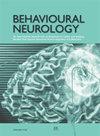近 20 年来轻度认知障碍伴多梦症的知识结构和新趋势:通过 CiteSpace 和 VOSviewer 进行的文献计量分析
IF 2.7
4区 医学
Q2 CLINICAL NEUROLOGY
引用次数: 0
摘要
背景。轻度认知障碍(MCI)是介于正常衰老和痴呆之间的一个中间阶段,由于其更容易发展为痴呆,因此已成为老年护理领域的一个突出研究领域。睡眠在认知功能中起着举足轻重的作用,睡眠障碍不仅会加重与神经退行性疾病相关的认知和情感症状,还会导致疾病进展。目的本文献计量分析调查了过去二十年来全球对伴有多梦的 MCI 的研究,旨在发现该领域的主要发现、研究领域和新趋势。研究方法。本研究以 "MCI "和 "睡眠 "为检索词进行文献计量分析。数据提取自科学网核心收藏数据库,并使用 CiteSpace 和 VOSviewer 进行了可视化和协作分析。研究结果这项研究涵盖了从 2003 年到 2023 年的 546 篇论文。随着时间的推移,发表量和引用率持续上升。神经科学、临床神经学和老年医学成为前三大研究领域。阿尔茨海默病杂志》的发表量最高,而《睡眠医学》的引用量最高。美国、中国和意大利的论文数量居前。作者和机构之间的合作群组已经确定,但群组之间的合作有限。活跃的共同参考文献集群包括 "阻塞性睡眠呼吸暂停"、"可能的中介途径 "和 "孤立的快速眼动睡眠行为障碍"。除 "MCI "外,最常被提及的关键词是 "阿尔茨海默病"、"痴呆症"、"风险因素 "和 "帕金森病"。值得注意的关键词群包括昼夜节律、帕金森病、MCI、路易体痴呆、主观认知障碍、路易体病、阿尔茨海默病和饮食模式。结论伴有多梦的 MCI 领域正在迅速扩大,涵盖了广泛的神经退行性疾病和睡眠障碍。目前的研究工作主要集中在阐明潜在的发病机制、预测疾病进展以及为受 MCI 伴有多梦症影响的患者制定创新的治疗策略。本文章由计算机程序翻译,如有差异,请以英文原文为准。
Knowledge Structure and Emerging Trends of Mild Cognitive Impairment with Dyssomnias in Recent 20 Years: A Bibliometric Analysis via CiteSpace and VOSviewer
Background. Mild cognitive impairment (MCI), an intermediate stage between normal aging and dementia, has emerged as a prominent research area in geriatric care due to its heightened propensity for progressing toward dementia. Sleep plays a pivotal role in cognitive function, with dyssomnias not only exacerbating cognitive and affective symptoms associated with neurodegenerative diseases but also contributing to disease progression. Aim. This bibliometric analysis investigates the global research on MCI with dyssomnias over the past two decades, aiming to discern key findings, research domains, and emerging trends in this field. Methods. In this study, a bibliometric analysis was conducted using the search terms “MCI” and “sleep”. Data were extracted from the Web of Science Core Collection database, and visualization and collaborative analysis were performed using CiteSpace and VOSviewer. Results. This study encompassed 546 publications from 2003 to 2023. The publication volume and citation rate consistently increased over time. Neurosciences, Clinical Neurology, and Geriatrics Gerontology emerged as the top three research fields. The Journal of Alzheimer’s Disease had the highest publication count, while Sleep Medicine received the most citations. USA, China, and Italy led in publication output. Collaborative clusters among authors and institutions were identified, but cooperation between clusters was limited. Active cocited reference clusters included “obstructive sleep apnea”, “possible mediating pathways”, and “isolated rapid eye movement sleep behaviour disorder”. The top frequently mentioned keywords, besides “MCI”, were “Alzheimer’s disease”, “dementia”, “risk factor”, and “Parkinson’s Disease”. Notable keyword clusters spanned circadian rhythm, Parkinson’s disease, MCI, dementia with Lewy body, subjective cognitive impairment, Lewy body disease, Alzheimer’s disease, and dietary patterns. Conclusion. The field of MCI with dyssomnias is rapidly expanding, encompassing a wide range of neurodegenerative disorders and sleep disturbances. Current research endeavors are primarily focused on elucidating the underlying pathogenesis, predicting disease progression, and developing innovative treatment strategies for individuals affected by MCI with dyssomnias.
求助全文
通过发布文献求助,成功后即可免费获取论文全文。
去求助
来源期刊

Behavioural Neurology
医学-临床神经学
CiteScore
5.40
自引率
3.60%
发文量
52
审稿时长
>12 weeks
期刊介绍:
Behavioural Neurology is a peer-reviewed, Open Access journal which publishes original research articles, review articles and clinical studies based on various diseases and syndromes in behavioural neurology. The aim of the journal is to provide a platform for researchers and clinicians working in various fields of neurology including cognitive neuroscience, neuropsychology and neuropsychiatry.
Topics of interest include:
ADHD
Aphasia
Autism
Alzheimer’s Disease
Behavioural Disorders
Dementia
Epilepsy
Multiple Sclerosis
Parkinson’s Disease
Psychosis
Stroke
Traumatic brain injury.
 求助内容:
求助内容: 应助结果提醒方式:
应助结果提醒方式:


